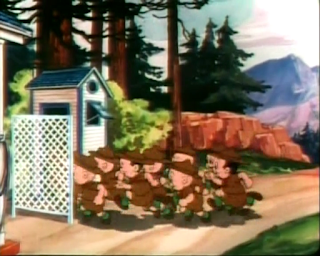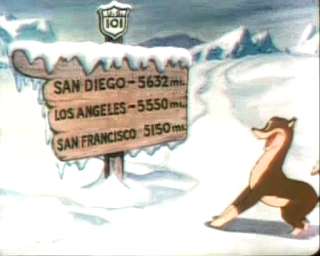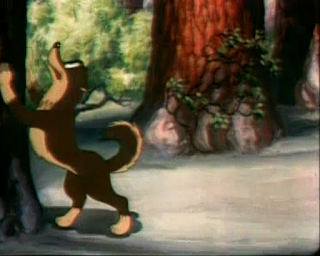 Release date:3/16/1940 (according to BCDb)
Release date:3/16/1940 (according to BCDb)DVD-Blu-Ray Availability: WHV DVD of the film Virginia City
You may view the uncensored version of this cartoon HERE.
In which the Avery unit achieves its apotheosis of the spot-gag format; a cartoon this well-constructed and funny makes up for several of the limp-dicked efforts in this vein, including some dreadful ones which fall like dead bodies through the 1940 and '41 releases.
Perhaps Avery and his men were refreshed by the one-cartoon break from this highly formulaic cartoon ritual. Maybe the gag writers had a good day at the races. Whatever caused it, Cross Country Detours is a solid, witty and playful cartoon that shows Avery's hand and sees him enjoying his work again.
The combo of Lou Marcelle's* calming narration and multi-layer tracking shot is de rigeur for this cartoon genre, and away we go...
We enter Yosemite National Park, where a well-meaning animal lover chooses to violate the orders of a sign--never a good idea in Tex Averyland.
Ya know what's going to happen, but the growing sophistication of the WB cartoon machine--Carl Stalling's precise musical cues and sharper character animation--sells us this old lunchmeat with a smile...
"WHASSAMATTER, STUPID? CAN'T YA READ?!?"
Fade to black.
Next, a "shy little deer" adopts a Mae West voice, gets a pet Stalling cue of "Oh, You Beautiful Doll" and gives us the first of two saucy rotoscoped bits, in a gag that is admirable for its brevity.
Next (and still in Yosemite), we bring in the Boy Scouts. Haven't done one of these image-background composites in awhile, so here:
Scoutmaster's worried look says volumes.
Gets OK from Ol' Granpop to use washroom...
Ten times funnier since the scouts are already in the frame, lined up, eager...
And a classic Avery joke cap: the scrawny afterthought. He will do this gag dozens of times through the rest of his animation career.
Three decent gags in 1:40! Avery's acceleration adds welcome freshness to this troubled genre.
The next sequence is entirely visual, and just from screenshots, it's clear as daylight what's going on. Here is masterful film-making in action.
Weirdest double take-shot in Avery's career?
Could the forest ranger be a staff caricature? His design is so out of place for the cartoon, and seems deliberately styled.It's hard not to think of the 1947 M-G-M Avery cartoon Red Hot Rangers, which has a lyrical outdoor sequence that bears comparison to this bit. We're now close enough to Avery's M-G-M work that we'll see a great deal of conceptual overlap from here to the conclusion of this blog. So much of the woodshedding that Avery did at Schlesinger's pays off handsomely in those later, slicker, better-budgeted Metro cartoons.
Narrator Marcelle can barely contain his cool when delivering this "natural bridge" gag in the colorful Bryce Canyon sequence. Brevity is its own hero.
We switch from the warm ochres of Utah to the chilling blues of Alaska. "Perfectly content in his sub-zero haunts is the polar bear..."
Bear does not buy Marcelle's BS:
"I don't care what you say... I'm cold."
Blue-airbrushed rear drives the point home. The smart backtalk might have already been familiar to audiences by 1940, but, once again, brevity is the soul of wit.
"Eskimo dogs thrive in this climate..."
"...and are perfectly happy here."
All but one, who skis into the foreground and spots an Avery Sign.
He scudders out of frame to investigate...
San Francisco lights him up.
Marcelle chuckles and wishes the dog "good luck" on his trip to California. We know this is a set-up for a big comedy payoff. 1940 audiences were still new to this business, and likely did not see the end of the fishing line here.
Fade into a moment right out of BBC's popular predator-eats-prey series Planet Earth.
Marcelle milks the mock-drama for all it's worth as the vicious bobcat approaches a fragile, trembling baby quail. We know what's going to happen, but for 1940 audiences, again, this had the shock of the new...Whomever animated the bobcat earned his paycheck... It's fully invested work, and another example of Avery making the absurd believable for just as long as it needs to be so.
Mel Blanc's impassioned "I can't do it!"s are priceless.
We are at the halfway mark of his unusually long cartoon (9:38--and part of the reason for it taking me so long to write this piece). Next...
"There's something fascinating about the sound of a frog..."
In a bit that I'm guessing has been cut from TV prints, Marcelle advises us, truthfully, that we're to see "a close-up of a frog... croaking..."
Among the best gags of Avery's long cartoon career, this bit still has shock value. His gift for lacing the innocuous with strychnine was seldom put to better use. Following this is another powerful precursor to his upcoming M-G-M days...
The look and feel of this disclaimer card, plus the way it intrudes upon the end of one scene and slides away to reveal the next, can be seen in several early M-G-Ms, including What's Buzzin' Buzzard? (1943). This is Avery's central distancing device of his early career, and, as in the M-G-Ms, it's accompanied by a jarring cymbal crash that dies away before the card is moved.
"In the desert wastes of New Mexico, we found interesting animal life, such as--"
--an intruding gag from an earlier scene.
The dog has left the wastes of Alaska en route to Northern California.
Marcelle chuckles at the dog, then returns to his original topic... another gag that I'm sure shocked its initial audiences, and still strikes an audacious note.
Marcelle mentions that the lizard "sheds its skin once a year. Let's watch this interesting procedure."To Stalling's accompaniment of "It Had To Be You," lizard becomes rotoscoped strip-tease artiste.
This sequence lasts nearly a minute--an eternity for a spot-gag cartoon--but the uncanny quality of the rotoscoped animation, plus Stalling's smothering mood music, makes each frame fascinating.
This was salacious stuff for 1940 cinemas, so Avery wisely self-censors for the end gag.
The fade to black ushers in a change of mood--and another of Avery's finest formal gags on the art of moviemaking. Marcelle warns us, to a black screen, that the next scene may contain images too shocking for younger viewers.
Thus, the screen is segregated...
the left side for adults only...
and the right side for the kiddies.
For adults, a vicious gila monster...
and a nauseous recitation for the children in the audience.
This is patently absurd, and the juxtaposition is wonderful. If this had been done before in animation, it must have been in the silent era. I can't recall a sound cartoon before this one that attempts such a feat. That the gila monster breaks the division line with his snarling adds to the effect.
The girl's curtsy seems to provoke the lizard to violence...
Tot turns the tables.
She really destroys the division mark.
Gila monster yelps like a hurt dog as it scampers into the horizon line.
Mark Kausler informs me that Rod Scribner--beloved for his scrambling, loose-limbed, manic-panic animation in the Bob Clampett unit of the mid-1940s--animated this remarkable scene. Some of Scribner's wild side is seen here, but his control, and the solidity of his form and movement, holds everything together.
It bears repeated noting that the animators really do the heavy lifting in Avery's cartoons. Without his ideas and timing, the material might fall flat, but without the strength of his animators, these would be only ideas on paper. Animation is easy to take for granted, especially when it does its job well. Take a moment to be thankful for the great artists who helped Avery's comic-filmic vision come to full life.
This uninterrupted stretch of brilliant comic-filmic ideas is the best it gets for the Avery spot-gag pictures. Had Avery and crew ended the cycle with Cross Country Detours, they (and we) would be spared the misery of the low-quality films that end this series. But we'll get to those all too soon...
Another multiplane nature view of the Grand Canyon, as Avery, Marcelle and Stalling keep it straight long enough for the audience to recover from that perfectly played hand.
Marcelle informs us that said canyon is famed for its crystal-clear echoes.
Tourist takes the bait.
"Hel-looooooo...."
Nuthin'.
"He-loooooooooo...."
Nada.
"HE-LOOOOOOOOOOOOOO!!!!!"
Central Casting operator voice informs shouter that his party does not answer.
He throws himself into a full-bodied Avery Take [TM].
Running dog gag again interrupts
Marcelle's genial blather.
Marcelle waxes rhapsodic about the winding Colorado River...
home to "busy little beavers" who are seen building a dam.
Big things happen quick in Avery's comic-filmic world.
Back to the dog! Marcelle celebrates his achievement of his
California goal: "What determination!"
With an incredible Expressionist take, dog realizes he's found paradise!
Well, almost paradise. He barks and bashes his way through San Diego...
LA...
Hollywood (hey, that's kind of a cheat...)
San Francisco*...
and, at last, the Big Trees of Northern Cali.
Blanc's performance of the dog as he rants about "Trees! Thousands and thousands of trees..."
"...and they're ALL MINE!"
...is among his best moments as a performer, and the naughty undertones of
this dog-piss gag brings today's cartoon to a rousing, manic close.
Cross Country Detours is a triumph for Avery and his unit. There isn't a wrong note or wasted moment in its almost 10 minutes of Technicolor film. The lack of filler, coupled with a fearless arsenal of formal devices, assaults the viewer with outrageous comic-filmic ideas and achieves a laugh with every sequence. What more could we ask of an animated cartoon?
That many of its gags are based on shocking or questionable turns is impressive. Cross Country Detours is a concerted effort by all hands on deck to make every moment count--and to get a rise out of the viewer as often as possible. In an ideal universe, Avery would have abandoned the topical spot-gag format after this cartoon. Alas, we have nine more of these to go. Some of them have moments of inspiration, and incubations of comic-filmic concepts the director would perfect at M-G-M, but these joyous moments come at a severe cost, as we'll sadly see.
Thank heavens, there's a great cartoon next--and one I hope to blog about before 2017 gets much older. Cancer treatment and heavy-weight projects have kept me away from this blog, but I intend to finish it. This will be the last blog I ever do, and I want to see it to completion.
* Thanks to cartoon voice expert Keith Scott for pointing out that Lou Marcelle, not Robert C. Bruce, is this cartoon's narrator. Marcelle apes Bruce's genial blather to a T. I certainly wouldn't have been able to tell the difference.
UP NEXT: Fractal fairy tales: The Bear's Tale








































































































































































Thanks for this great post, Frank. Tex really wanted the performances just right for this cartoon, so he filmed himself acting out the bobcat's "I can't do it!" shot, and I suspect he must have shot live action for the dog's "millions of trees" line. The live action film still exists of the stripper he filmed for the lizard's skin shedding scene. The great Rod Scribner animated the gila monster and the little girl split screen sequence. This is one of my favorite Tex Avery Warner cartoons, I'm glad you like it too. Every good wish for your health and busy schedule, thanks for continuing with the blog.
ReplyDeleteWelcome back! It's nice to see you again, and even better, with a memorable cartoon.
ReplyDeleteI concur with Mark. When I revisited this one years ago I was struck by how well everything sings, compared to how uneven Avery's other travelogue spoofs had been and would be. We're getting into Avery's second wind at Schlesinger's when he'd create classic after classic. There are still a few duds to come, but the best ones are the best WB cartoons of the period, no contest.
ReplyDeleteVery good cartoon. It had been mentioned about 20 years ago on rec.arts.animation-wanrer-bros that Lou Marcelle narrated this catoon. there would be some other one where Robert C.Bruce didn't narrate--Gil Warren and Frank Graham narrated some of these.:)
ReplyDeleteThis has always been a favorite of mine. For its length, every moment is solid and enjoyable. Is it just me, or does the heavy set tourist that tries to produce an echo seem like a dead ringer for the fat Elmer Fudd that would appear a little over a year later?
ReplyDeleteIt's not you. I noticed it too.
Delete